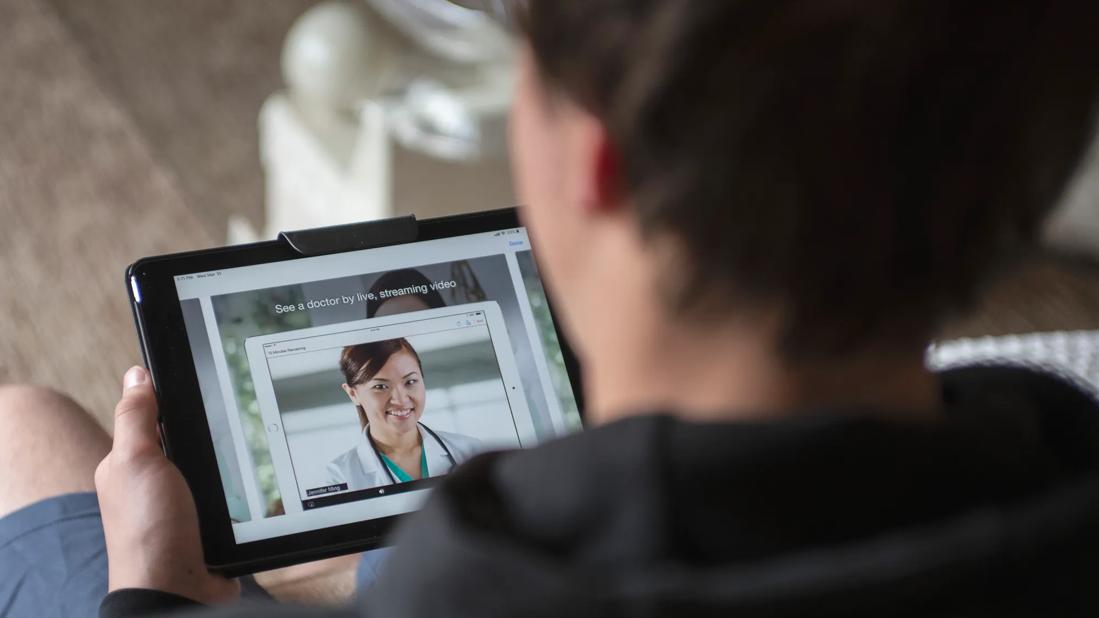COVID-19 may have triggered the transition

For nearly two years, Cleveland Clinic internal medicine physician Daniel Sullivan, MD, conducted about two virtual patient visits per week. Since the COVID-19 crisis, that number has skyrocketed to more than 50 per week.
Advertisement
Cleveland Clinic is a non-profit academic medical center. Advertising on our site helps support our mission. We do not endorse non-Cleveland Clinic products or services. Policy
Virtual visits for all primary care providers using Cleveland Clinic’s Express Care® Online platform have increased 26-fold in recent weeks.
“Telemedicine has been a preferred option for patients with transportation or ambulation challenges, but the number of people who physically can’t get to office visits has been relatively small,” says Dr. Sullivan. “Traditionally, most patients have assumed that the only way to see a doctor is to come to a clinic. The COVID-19 pandemic has revealed the truth: More primary care patients can have their care needs met through telemedicine.”
Since the outbreak of COVID-19 in Ohio, Cleveland Clinic primary care teams have been working to “flatten the curve” by steering patients to Express Care Online for nearly everything but emergent symptoms. Primary care providers evaluate patients remotely, preventing an influx of patients at clinics, thereby potentially reducing viral spread.
Patients with concerning symptoms are sent to appropriate locations for further assessment or testing. For example, those with two or more COVID-19 symptoms — cough, shortness of breath, temperature of 100.4 ˚F or higher, and diarrhea — who have certain chronic conditions or are over age 60 are scheduled for drive-through COVID-19 testing.
“The drive-through ‘waiting room’ is your car,” says Dr. Sullivan. “From presentation to diagnosis, we can effectively isolate patients from each other and from our healthcare providers.”
Telemedicine visits also help reassure patients who don’t need COVID-19 testing.
Advertisement
Admittedly, telemedicine can’t do it all. In-office visits still are required for patients needing hands-on care for diagnosing abdominal or chest pain, for example.
“We still need to feel where tenderness in the belly may be or listen to a patient’s heart and lungs,” says Dr. Sullivan. “But innovative remote technologies soon may help with some of that.”
Some patients already have their own blood pressure cuff at home. And at-home pulse oximetry is becoming more popular. As these and other technologies become more mainstream and better connected with medical offices, they will augment telemedicine capabilities.
Cleveland Clinic primary care teams aren’t using remote devices yet. But even without them, telemedicine visits still provide value for most primary care patients, says Dr. Sullivan.
“By anecdotal estimates, seasoned providers can home in on a diagnosis about 80% of the time based on patient history alone,” he says.
Until the COVID-19 crisis, commercial insurers, Medicare and Medicaid were hesitant to cover telemedicine visits. The reason was multifactorial, says Dr. Sullivan, but likely centered on preventing increased healthcare costs.
“It seemed too easy to pick up the phone, talk to your doctor and incur a medical bill,” he says. “But what we’re seeing now, thanks to COVID-19 social isolation mandates, is that telemedicine is actually helping lower healthcare costs.”
Virtual visits mean fewer clinical rooms need to be lit, heated, cleaned and otherwise maintained.
“Economy of resources is the best incentive for payers to increase availability of telemedicine,” says Dr. Sullivan. “For patients with chronic conditions, who are following their care plan and managing well, there isn’t always a need for in-office follow-ups. Checking in virtually may suffice and cost less.”
Advertisement
He adds, easier access to primary care providers also may prevent overuse of emergency departments, which some patients have used as a costlier — although more convenient — alternative to scheduling in-office primary care visits.
Whether or not payers will continue to cover telemedicine visits once the COVID-19 crisis abates remains to be seen. Yet Dr. Sullivan is optimistic that telemedicine could become the new normal for primary care practices.
“In my experience, roughly half of the patients we touch — maybe more — could be using this platform,” he says.
He suggests viewing telemedicine as a supplement to office-based care, rather than a substitute. Patients with hypertension or diabetes, for example, could benefit from a blended approach. So could patients recently discharged from the hospital.
“Just this morning, I met with an 87-year-old patient via Express Care Online,” says Dr. Sullivan. “He was discharged two weeks ago. We talked about if his medications were agreeing with him. I asked about his breathing, eating and walking. I verified that he was scheduled for bloodwork and a chest X-ray in two weeks. We got everything done in 15 minutes. Before the COVID-19 crisis, he would have had to come to my office for that.”
One or two generations ago, when home computers and mobile phones weren’t ubiquitous, the rise of telemedicine was unlikely.
“The world has changed, and healthcare needs to change with it,” Dr. Sullivan concludes.
Advertisement
Advertisement

Patients report improved sense of smell and taste

Clinicians who are accustomed to uncertainty can do well by patients

Unique skin changes can occur after infection or vaccine

Cleveland Clinic analysis suggests that obtaining care for the virus might reveal a previously undiagnosed condition

As the pandemic evolves, rheumatologists must continue to be mindful of most vulnerable patients

Early results suggest positive outcomes from COVID-19 PrEP treatment

Could the virus have caused the condition or triggered previously undiagnosed disease?

Five categories of cutaneous abnormalities are associated with COVID-19